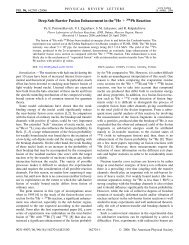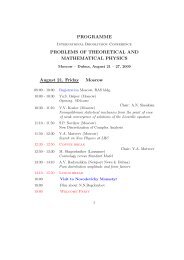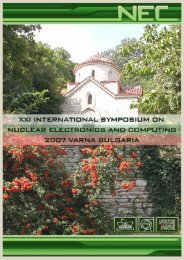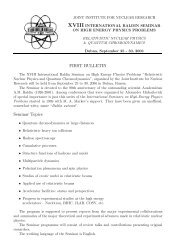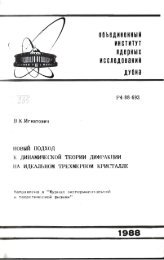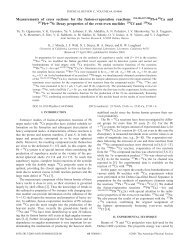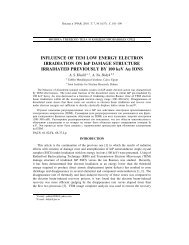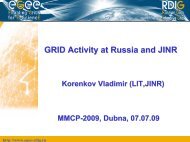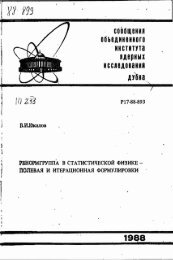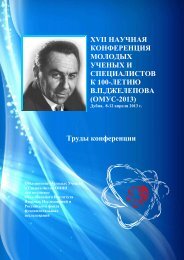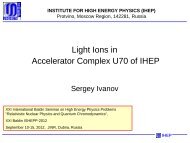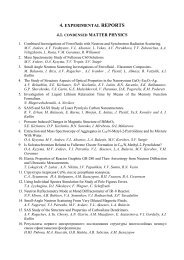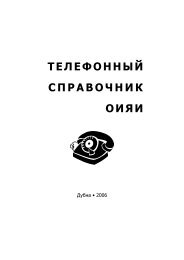Joint Institute for Nuclear Research Relativistic ... - Index of - JINR
Joint Institute for Nuclear Research Relativistic ... - Index of - JINR
Joint Institute for Nuclear Research Relativistic ... - Index of - JINR
Create successful ePaper yourself
Turn your PDF publications into a flip-book with our unique Google optimized e-Paper software.
THE PHOTON CLUSTER EXCITATION MECHANISM OF THE e − e +<br />
PLASMA CREATED FROM THE VACUUM IN A STRONG<br />
ELECTROMAGNETIC FIELD<br />
S. A. Smolyansky 1† , D. B. Blaschke 2,3 , V. V. Dmitriev 1 , B. Kämpfer 4,5 , S. M. Schmidt 6,7 ,<br />
A. V. Prozorkevich 1 , and A. V. Tarakanov 1<br />
(1) Saratov State University, RU - 410026 Saratov, Russia<br />
(2) <strong>Institute</strong> <strong>for</strong> Theoretical Physics, University <strong>of</strong> Wroc̷law, 50-204 Wroc̷law, Poland<br />
(3) Bogoliubov Laboratory <strong>for</strong> Theoretical Physics, <strong>Joint</strong> <strong>Institute</strong> <strong>for</strong> <strong>Nuclear</strong> <strong>Research</strong>,<br />
RU - 141980 Dubna, Russia<br />
(4) Helmholtzzentrum Dresden-Rossendorf, PF 510119, 01314 Dresden, Germany<br />
(5) Institut für Theoretische Physik, TU Dresden, 01062 Dresden, Germany<br />
(6) Forschungszentrum Jülich GmbH, D-52428 Jülich, Germany<br />
(7) Technische Universität Dortmund, Fakultät Physik & DELTA,<br />
D - 44221 Dortmund, Germany<br />
† E-mail: smol@sgu.ru<br />
Some features <strong>of</strong> the momentum distribution <strong>of</strong> the residual e − e + pair plasma (EPPP)<br />
createdfromthevacuuminastronglaserfieldinthemultiphotondomainγ = 2πE c λ c /E 0 λ ><br />
1 (E 0 and λ are the field strength amplitude and wavelength <strong>of</strong> the external electric field)<br />
areinvestigated in the low density approximation to the nonperturbative kinetic approach<br />
(e.g., [1, 2]). The traditional multiphoton mechanism <strong>of</strong> EPPP excitations is examined in<br />
comparison with the new photon cluster mechanism found in [3], where a photon cluster<br />
is introduced as a system <strong>of</strong> identical photons that act as one photon having the total<br />
energy <strong>of</strong> this system. We analyze the role <strong>of</strong> the simplest elementary photon processes<br />
in the EPPP with and without the assistance <strong>of</strong> the photon clusters, as well as the case<br />
<strong>of</strong> large photon numbers. These calculations are intended to find simple estimations <strong>of</strong><br />
the secondary processes associated with the dynamical Schwinger effect [4, 5, 6, 7].<br />
References<br />
[1] S. M. Schmidt et al., Int. J. Mod. Phys. E 7, 709 (1998) [arXiv:hep-ph/9809227].<br />
[2] S. M. Schmidt et al., Phys. Rev. D 59, 094005 (1999) [hep-ph/9810452].<br />
[3] D. B. Blaschke, B. Kämpfer, A. D. Panferov, A. V. Prozorkevich, S. A. Smolyansky,<br />
arXiv:1205.3154v1 [physics.plasm-ph].<br />
[4] D. B. Blaschke et al., Phys. Rev. Lett. 96, 140402 (2006) [nucl-th/0511085].<br />
[5] D. B. Blaschke et al., Eur. Phys. J. D 55, 341 (2009).<br />
[6] G. Gregori et al., High Energy Dens. Phys. 6, 166 (2010) [arXiv:1005.3280 [hep-ph]].<br />
[7] D. B. Blaschke, V. V. Dmitriev, G. Röpke, S. A. Smolyansky, Phys. Rev. D84,<br />
085028 (2011) [arXiv:1105.5397 [hep-ph]].<br />
117



